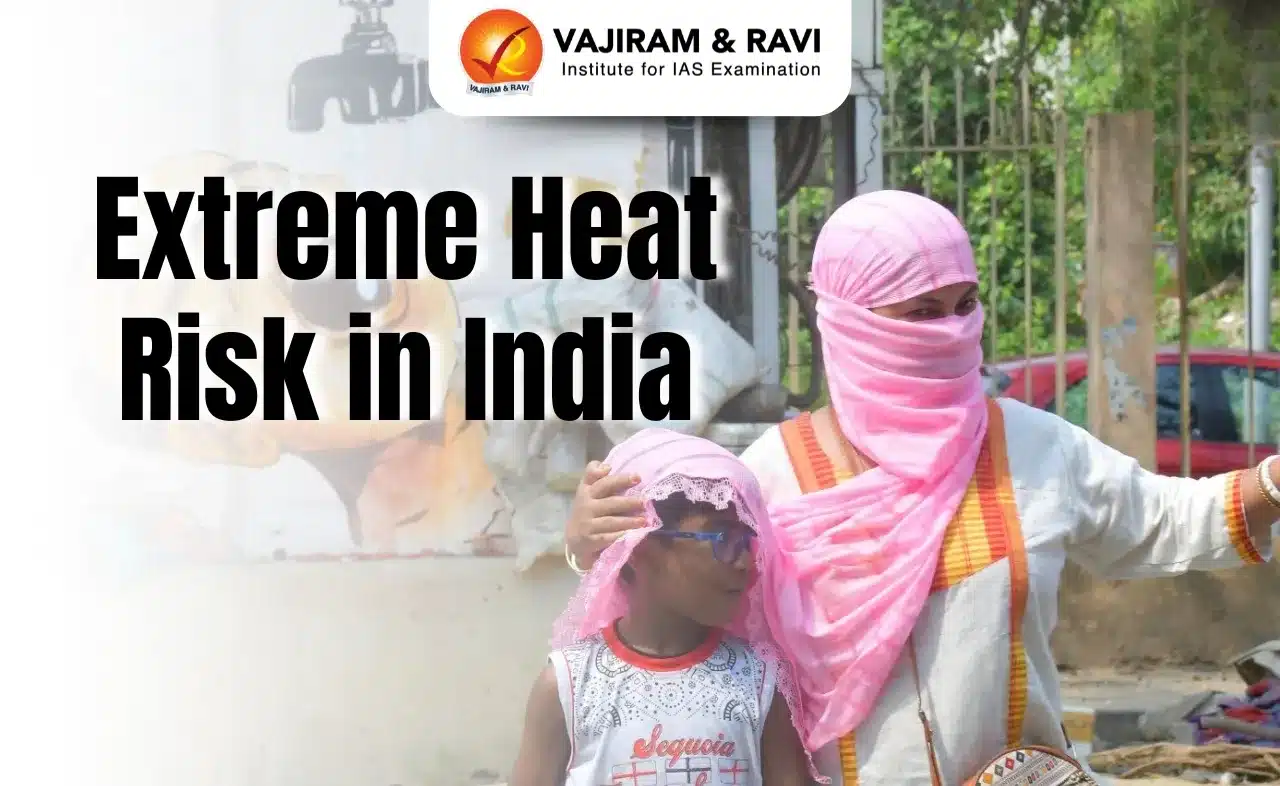Extreme Heat Risk in India Latest News
- A recent study by the Council on Energy, Environment and Water (CEEW), titled ‘How Extreme Heat is Impacting India’, reveals that 57% of Indian districts, home to 76% of the population, face high or very high risk from extreme heat.
- States facing the highest risk include Delhi, Maharashtra, Goa, Kerala, Gujarat, Rajasthan, Tamil Nadu, Andhra Pradesh, Madhya Pradesh, and Uttar Pradesh.
- The Council on Energy, Environment and Water (CEEW), based in New Delhi, is one of the world’s leading and best-managed independent climate think tanks.
Understanding Heat Risk: Not the Same as Heatwaves or Heat Stress
- Heatwaves
- While they do not have a universal definition, heatwaves are essentially prolonged periods of abnormally high temperatures in a specific region.
- Heat Stress
- Occurs when the body temperature exceeds 37°C.
- Body struggles to release excess heat, causing discomfort, cramps, and exhaustion.
- If body temperature exceeds 40°C, it may lead to heat stroke.
- Heat Risk
- According to the CEEW study, heat risk refers to the probability of heat-related illness or death due to extreme temperatures.
- It is determined by three key factors:
- Intensity of heat and compounding effects (e.g., humidity),
- Degree of exposure, and
- Vulnerability of affected communities (e.g., age, health conditions).
Key Factors Driving Heat Risk in India
- Rise in Very Warm Nights
- Between 2012 and 2022, over 70% of Indian districts experienced five or more additional very warm nights each summer.
- Warm nights prevent the body from cooling down after hot days, increasing the risk of heat strokes and worsening non-communicable diseases like diabetes and hypertension.
- Increase in Relative Humidity in North India
- Relative humidity in the Indo-Gangetic Plain rose from 30–40% (1982–2011) to 40–50% (2012–2022).
- High humidity hampers cooling through sweat, intensifying heat stress, especially when body temperature exceeds 37°C.
- Urbanisation and Population Density
- Cities like Mumbai and Delhi face higher exposure due to dense populations.
- Rapid urbanisation in tier II and III cities has led to increased night-time heat due to heat-absorbing concrete infrastructure.
- Socio-Economic and Health Vulnerabilities
- Districts in Andhra Pradesh, Maharashtra, Haryana, Punjab, Chhattisgarh, Bihar, and Uttar Pradesh are particularly vulnerable.
- Factors include a high share of elderly populations and prevalence of chronic health conditions (e.g., diabetes, hypertension).
Key Findings of The Study
- 2024: Warmest Year on Record
- 2024 marked the hottest year globally, including in India.
- Global average temperature was 1.5°C above pre-industrial levels (1850–1900).
- India’s temperature was 1.2°C higher than the 1901–1910 average.
- India’s Climate Impact: Already Evident
- India experienced its longest recorded heatwave since 2010.
- Over 44,000 cases of heatstroke were reported in 2024 alone.
- Inadequate Heat Action Plans (HAPs)
- India’s HAPs (early warning and preparedness plans) are often:
- Lacking long-term strategies, or
- Poorly implemented, even when they exist.
- According to the Sustainable Futures Collaborative (SFC), this weakens India’s response to growing heat threats.
- Future Risks
- Without stronger planning and execution, heat-related deaths may rise.
- The country faces increasing threats from more frequent, intense, and prolonged heatwaves.
Extreme Heat Risk in India FAQs
Q1: What percentage of Indian districts face extreme heat risk?
Ans: 57% of Indian districts face high or very high heat risk, affecting around 76% of India’s population.
Q2: What is heat risk as per CEEW?
Ans: Heat risk is the likelihood of heat-related illness or death based on heat intensity, exposure, and community vulnerabilities.
Q3: Which factors drive heat risk in India?
Ans: Very warm nights, rising humidity, urbanisation, high population density, and vulnerable populations drive heat risk in India.
Q4: Which regions are most affected by heat risk?
Ans: Delhi, Maharashtra, Kerala, Rajasthan, Uttar Pradesh, and other populous states face the highest levels of extreme heat risk.
Q5: Why are current Heat Action Plans inadequate?
Ans: Most Heat Action Plans lack long-term strategies or effective implementation, risking more heat-related illnesses and deaths.






